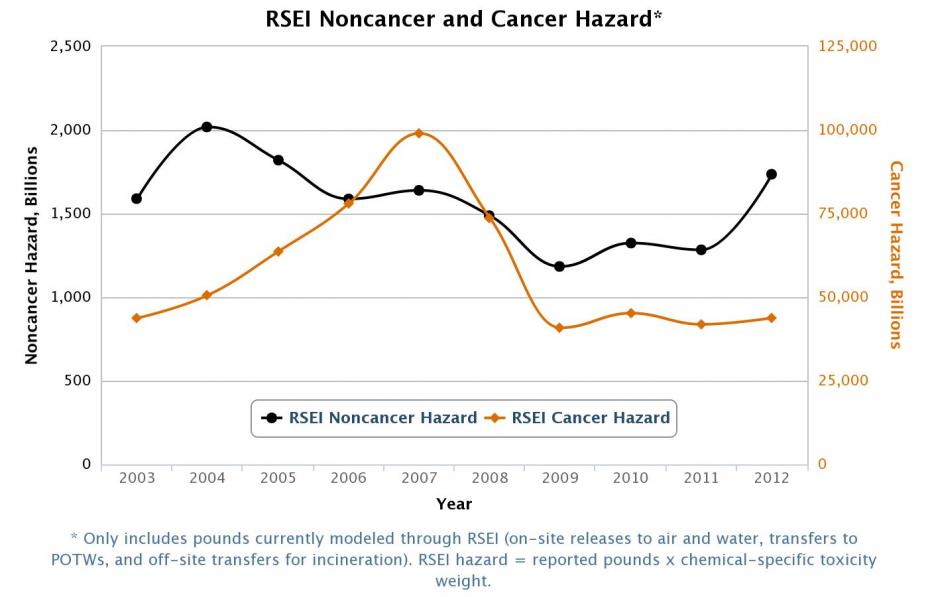2013 TRI National Analysis: Hazard and Risk of TRI Chemicals
Section 7: Hazard and Risk of TRI Chemicals
Helpful Concepts
The hazard of a toxic chemical is its ability to cause an increased incidence of adverse health effects (e.g., cancer, birth defects). Toxicity is a way to measure the hazard of a chemical.
The risk of a toxic chemical is the chance of adverse health effects occurring as a result of exposure to the chemical. Risk is a function of hazard and exposure.
TRI provides information about releases of toxic chemicals from industrial facilities throughout the United States. However, trends in pounds of chemical releases do not account for potential risk of chemical releases. Although TRI cannot tell an individual whether or to what extent they might have been exposed to these chemicals, you can use it as a starting point in evaluating potential risks to human health and the environment.
First, it is helpful to introduce the concepts of hazard and risk. The hazard of a toxic chemical is its ability to cause an increased incidence of adverse health effects (e.g., cancer, birth defects). Toxicity is a way to measure the hazard of a chemical. While there are many definitions of the word risk, EPA considers risk to be the chance of adverse effects to human health or to ecological systems resulting from exposure to an environmental stressor (e.g., a toxic chemical).
Human health risk is determined by many factors, including:
- The hazard (or toxicity) of the chemical(s)
- The quantity of the chemical(s)
- The fate of the chemical in the environment
- The route of exposure (inhalation, ingestion, dermal absorption)
- Frequency and length of exposure
- Individual susceptibility (e.g., genetics, life stage, health status)
TRI contains some of this information, including what chemicals are released from industrial facilities; the amount of each chemical released; and the amounts released to air, water, and land. The next figure shows some of the factors that influence an individual’s risk from a toxic chemical exposure.
Overview of Factors that Influence Risk

It is important to keep in mind that while TRI captures a significant portion of toxic chemicals in wastes managed, including how chemicals are released by industrial facilities, it does not cover all facilities, all toxic chemicals, or all sources of toxic chemicals in a community. For example, potential sources of chemical exposure that would not be in TRI include exhaust from cars and trucks, chemicals in consumer products, and chemical residues in food and water.
Risk-Screening Environmental Indicators
The RSEI model considers more than just chemical quantities released, including:
- Location of releases
- Toxicity of the chemical
- Fate and transport
- Human exposure pathway
To provide information on the potential hazard and risk of disposal or other releases, the TRI Program presents its data from EPA’s publicly available Risk-Screening Environmental Indicators (RSEI) model. The RSEI model includes TRI data on on-site releases to air and water, transfers to Publicly Owned Treatment Works (POTWs) and transfers for off-site incineration. Other release pathways, such as land disposal, are not currently included in the RSEI model.
The model produces a hazard estimate and a unitless risk “score,” which represents relative chronic human health risk. Each type of result can be compared to results of the same type from other years.
- The hazard estimates consist of the pounds released multiplied by the chemical's toxicity weight. They do not include any exposure modeling or population estimates.
- RSEI risk scores are calculated using on-site releases to air and water, transfers to POTWs, and transfers for off-site incineration as reported to TRI. Note that other release pathways, such as land disposal, are not currently modeled in RSEI. The scores are based on many factors including the amount of the chemical released, the location of the release, the chemical’s toxicity, its fate and transport through the environment, and the route and extent of potential human exposure.
RSEI is a screening-level model that uses simplifying assumptions to fill data gaps and reduce the complexity of calculations in order to quickly evaluate large amounts of data and produce a simple score. The model should be used for screening-level activities such as trend analyses at the national level that compare relative risk from year to year, or ranking and prioritization of chemicals or industry sectors for strategic planning. RSEI is not a formal risk assessment, which typically requires site-specific information and detailed population distributions to predict exposures for estimating potential health effects. Instead, RSEI is commonly used to quickly screen and highlight situations that may potentially lead to chronic human health risks. Because modeling the exposure of TRI chemicals is time and resource intensive, only RSEI data through 2012 are currently available. More information about the model can be accessed at the RSEI webpage.
Most disposal or other release practices are subject to a variety of regulatory requirements designed to limit environmental harm. To learn more about what EPA is doing to help limit the release of harmful chemicals to the environment see EPA’s laws and regulations page.
| Graphics in this section | |
|---|---|
| Hazard Trend and Corresponding Releases |
Risk Trend and Corresponding Releases |
This page was published in January 2015 and uses the 2013 TRI National Analysis dataset made public in TRI Explorer in October 2014.


